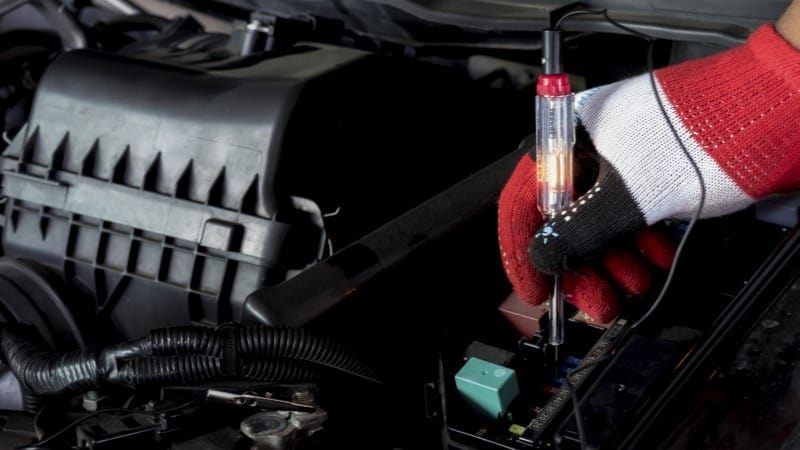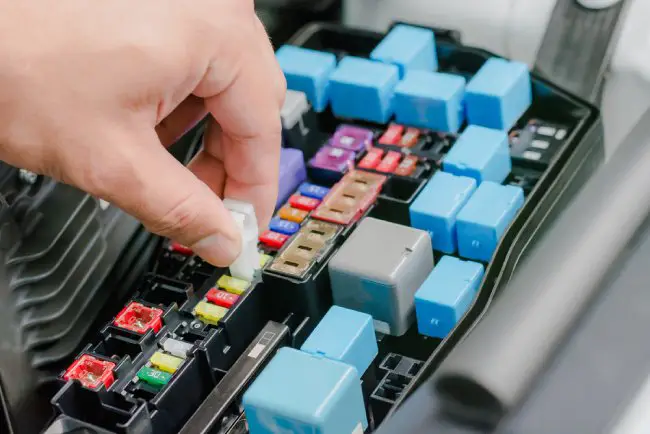Your car’s automatic shutdown relay or ASD is a safety feature that ensures the battery current is shut off when you turn off the ignition while the key is in it. We don’t think about this safety feature until the ASD relay is faulty and the car won’t start.
Here we will look at the signs of a faulty ASD relay, why the ASD relay goes bad, and three methods to fix it with step-by-step instructions.
ASD relay explained
The ASD relay supplies power to the ignition coils, fuel injectors, and the oxygen sensor heat relays and elements in some cars. This safety feature helps ensure these circuits shut down when you turn the vehicle off.
When you restart the car, there needs to be enough current flow that all circuits fire up and start the vehicle. When this doesn’t happen, there is a faulty ASD relay.
Symptoms of a Faulty ASD relay

-
Engine won’t crank
When a circuit that receives power from the ASD relay doesn’t fire up, it affects all the circuits, resulting in the engine not cranking.
As a result, the ASD relay can create a situation where one of the circuits receives little to no power as your key turns.
-
ASD relay emits a clicking noise
A lack of voltage to the ASD relay can cause a clicking noise (this problem is well known in Jeeps). The battery may be fully charged but the ECU reads it as a poorly charged battery.
It is common for the car to start with a jump, but when you remove the jumper cable, the car dies, and the clicking returns.
There may be wire breakage caused by battery acid on some vehicles when the ASD ground wire is under the battery.
-
Engine stalls after starting
A well-known symptom is stalling out after starting. It can happen right after starting or later while driving.
When the ASD relay is faulty, the heat sensors, fuel injectors, and ignition coils don’t get enough voltage to work correctly, leaving your engine to stall once started.
-
Check engine light is on
Check engine lights comes on when the car’s computer finds a problem it can’t correct. The light alerts you to have the vehicle scanned or look at it yourself and fix the problem.
Why the relay goes bad
- Inrushing currents
At some point in the voltage relay, there is a surge of higher current to a lower current source, this is inrushing current.
- Spikes in voltage
An increase in voltage for more than a nanosecond caused by static electricity, lightning, a magnetic field, or an internal change is a voltage spike.
- Hot switch in capacitive loads
If there are many closures on a matrix of switching at a single Y-axis to the X connections, there will be an increase in the capacitive load.
In addition, the ASD relay will be affected while the switch is hot.
- UUTs are faulty
When accidents and faults in the UUTs (units under testing) occur, the ASD relay can go wrong. The cause of this is probably a lower-level signal application.
- Contacts are degraded
An ASD relay malfunction can result from worn contacts, damaged coils, and activating a mechanical failure resulting in contact degradation.
- Hot switch in inductive Loads
The ASD relay opens and closes while the signal (hot switching) shows. When the relay becomes hotter than the other switches, it can burn itself out.
Sounds of a faulty ASD relay
The sounds you may hear when your ASD relay goes bad are clicking when starting the car, faint pinging on starting the vehicle, and sometimes when the car is off.
In Jeeps, there are claims of a buzzing when the vehicle is started or running.
Tools for bypassing the ASD relay
- Screwdriver
- Owner’s manual
- Pliers
- Socket Wrench and sockets
Parts you may need for bypassing the ASD relay
Be sure to check your owners manual to ensure the below parts are the exact match for your vehicle.
- ASD relay for your make and model of car
- New power module for your make and model of car
- Double-ended cable with 12V output terminal end.
How to Bypass ASD Relay

1. Power module ASD relay
Step 1: Using a wrench, remove the negative battery cable. When you set it aside, make sure it doesn’t touch any metal.
Step 2: Find the ASD relay (your owner’s manual will have this information). If you don’t have your car’s manual, contact a dealership.
You will need to know if it is a single relay or situated in the power module (located in the relay box or the firewall).
Step 3: Locate the wiring harness connector on the power module and unplug the harness (usually found near the front passenger side).
If your car has a screw that holds the plugs and the tangs, unscrew and remove this.
If not, use your fingers to move the tangs on the plugs. Then, pulling the tangs apart, remove the connector from the power module.
Step 4: Loosen and remove the bracket securing the power module using a socket wrench.
Placing the new power module in its place and rebolt it, and plug the harness wiring back in.
Note: If it needs screwing down, do so without over-tightening the screws, this can damage the connector’s pins, and the housing, which is plastic and will crack if the bolt is too tight).
To make sure the power module and ASD relay are working correctly, start the car, then reattach to the battery the negative battery cable.
2. Power module with separate ASD relay
Step 1: Using your owner’s manual, find the diagram of your relays and fuses and locate the faulty relay.
Step 2: Remove the faulty relay with your fingers or a pair of pliers. Use a rocking motion from side to side as you pull upwards.
Step 3: Replace the faulty relay with the new relay by pushing it into place without damaging or bending the connection or the terminal.
The new relay should slip easily into the space. Then start the car to make sure everything is working.
3. How to relay bypass one wire
Step 1: PCM relay removal
You can remove the PCM relay using your fingers. It should pull out easily.
Step 2: Does the car start?
Once it is out, the car will no longer start.
Step 3: Position the cable in the 12V output terminal
Take your double-ended cable and place one end in the 12V output terminal and the other end of the plug in the PCM. This wire will be the relay while the ASD relay is out.
Step 4: Power the PCM with the cable
While the one end is in the 12V output terminal, place the other end in the PCM.
Step 5: Listen for the fuel pump prime
As you push the wire’s end into the 12V output terminal, you will hear the fuel pump priming followed by a few soft clicks. Get in the car and start the engine.
Step 6: Pull off the cable to shut off the engine
Get out of the car and remove the bypass wire. The vehicle should go off immediately.
Quick ASD relay bypass tips
- While removing cables or wires, be sure to keep them away from metal. You don’t want to short out anything or get zapped with electricity.
- If using pliers to remove the relay, be careful not to damage the plastic housing on the automatic shutdown relay.
- When tightening the power module bolts, do not over-tighten the screws because it will damage the power module connector’s pins.










Leave a Comment